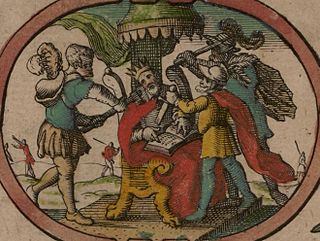Related Research Articles

Rædwald, also written as Raedwald or Redwald, was a king of East Anglia, an Anglo-Saxon kingdom which included the present-day English counties of Norfolk and Suffolk. He was the son of Tytila of East Anglia and a member of the Wuffingas dynasty, who were the first kings of the East Angles. Details about Rædwald's reign are scarce, primarily because the Viking invasions of the 9th century destroyed the monasteries in East Anglia where many documents would have been kept. Rædwald reigned from about 599 until his death around 624, initially under the overlordship of Æthelberht of Kent. In 616, as a result of fighting the Battle of the River Idle and defeating Æthelfrith of Northumbria, he was able to install Edwin, who was acquiescent to his authority, as the new king of Northumbria. During the battle, both Æthelfrith and Rædwald's son, Rægenhere, were killed.

Sutton Hoo is the site of two Anglo-Saxon cemeteries dating from the 6th to 7th centuries near Woodbridge, Suffolk, England. Archaeologists have been excavating the area since 1938, when a previously undisturbed ship burial containing a wealth of Anglo-Saxon artefacts was discovered. The site is important in establishing the history of the Anglo-Saxon kingdom of East Anglia as well as illuminating the Anglo-Saxons during a period which lacks historical documentation.

The Benty Grange helmet is an Anglo-Saxon boar-crested helmet from the 7th century AD. It was excavated by Thomas Bateman in 1848 from a tumulus at the Benty Grange farm in Monyash in western Derbyshire. The grave had probably been looted by the time of Bateman's excavation, but still contained other high-status objects suggestive of a richly furnished burial, such as the fragmentary remains of a hanging bowl. The helmet is displayed at Sheffield's Weston Park Museum, which purchased it from Bateman's estate in 1893.

The Snape Anglo-Saxon Cemetery is a place of burial dated to the 6th century AD located on Snape Common, near to the town of Aldeburgh in Suffolk, Eastern England. Dating to the early part of the Anglo-Saxon Era of English history, it contains a variety of different forms of burial, with inhumation and cremation burials being found in roughly equal proportions. The site is also known for the inclusion of a high status ship burial. A number of these burials were included within burial mounds.

Eorpwald; also Erpenwald or Earpwald,, succeeded his father Rædwald as ruler of the independent Kingdom of the East Angles. Eorpwald was a member of the East Anglian dynasty known as the Wuffingas, named after the semi-historical king Wuffa.

Hanging bowls are a distinctive type of artefact of the period between the end of Roman rule in Britain in c. 410 AD and the emergence of the Christian Anglo-Saxon kingdoms during the 7th century. The surviving examples have mostly been found in Anglo-Saxon graves, but there is general agreement that they reflect Celtic traditions of decoration.
Martin Oswald Hugh Carver, FSA, Hon FSA Scot, is Emeritus Professor of Archaeology at the University of York, England, director of the Sutton Hoo Research Project and a leading exponent of new methods in excavation and survey. He specialises in the archaeology of early Medieval Europe. He has an international reputation for his excavations at Sutton Hoo, on behalf of the British Museum and the Society of Antiquaries and at the Pictish monastery at Portmahomack Tarbat, Easter Ross, Scotland. He has undertaken archaeological research in England, Scotland, France, Italy and Algeria.
Charles William Phillips was a British archaeologist best known for leading the 1939 excavation of the Sutton Hoo burial ship, an intact collection of Anglo-Saxon grave-goods. In 1946, he replaced O. G. S. Crawford as the Archaeology Officer of the Ordnance Survey. He was awarded the Victoria Medal of the Royal Geographical Society in 1967 for his contributions to the topography and mapping of Early Britain.
Basil John Wait Brown was an English archaeologist and astronomer. Self-taught, he discovered and excavated a 6th-century Anglo-Saxon ship burial at Sutton Hoo in 1939, which has come to be called "one of the most important archaeological discoveries of all time". Although Brown was described as an amateur archaeologist, his career as a paid excavation employee for a provincial museum spanned more than thirty years.

The Dig is a historical novel by John Preston, published in May 2007, set in the context of the 1939 Anglo-Saxon ship burial excavation at Sutton Hoo, Suffolk, England. The dust jacket describes it as "a brilliantly realized account of the most famous archaeological dig in Britain in modern times".

Rupert Leo Scott Bruce-Mitford, FBA, FSA was a British archaeologist and scholar. He spent the majority of his career at the British Museum, primarily as the Keeper of the Department of British and Medieval Antiquities, and was particularly known for his work on the Sutton Hoo ship-burial. Considered the "spiritus rector" of such research, he oversaw the production of the monumental three-volume work The Sutton Hoo Ship-Burial, termed by the president of the Society of Antiquaries as "one of the great books of the century".

The Sutton Hoo helmet is a decorated Anglo-Saxon helmet found during a 1939 excavation of the Sutton Hoo ship-burial. It was buried around the years c. 620–625 CE and is widely associated with an Anglo-Saxon leader, King Rædwald of East Anglia; its elaborate decoration may have given it a secondary function akin to a crown. The helmet was both a functional piece of armour that would have offered considerable protection if ever used in warfare, and a decorative, prestigious piece of extravagant metalwork. An iconic object from an archaeological find hailed as the "British Tutankhamen", it has become a symbol of the Early Middle Ages, "of Archaeology in general", and of England.

The Sutton Hoo purse-lid is one of the major objects excavated from the Anglo-Saxon royal burial-ground at Sutton Hoo in Suffolk, England. The site contains a collection of burial mounds, of which much the most significant is the undisturbed ship burial in Mound 1 containing very rich grave goods including the purse-lid. The person buried in Mound 1 is usually thought to have been Rædwald, King of East Anglia, who died around 624. The purse-lid is considered to be "one of the most remarkable creations of the early medieval period." About seven and a half inches long, it is decorated with beautiful ornament in gold and garnet cloisonné enamel, and was undoubtedly a symbol of great wealth and status. In 2017 the purse-lid was on display at the British Museum.

Nigel Reuben Rook Williams was an English conservator and expert on the restoration of ceramics and glass. From 1961 until his death he worked at the British Museum, where he became the Chief Conservator of Ceramics and Glass in 1983. There his work included the successful restorations of the Sutton Hoo helmet and the Portland Vase.

Peter Charles van Geersdaele was an English conservator best known for his work on the Sutton Hoo ship-burial. Among other work he oversaw the creation of a plaster cast of the ship impression, from which a fibreglass replica of the ship was formed. He later helped mould an impression of the Graveney boat, in addition to other excavation and restoration work.

Mercie Kerr Lack ARPS (1894-1985) was a British teacher and photographer particularly known for her photography of the discoveries at the site of Sutton Hoo in 1939,, and for her photographs of London street scenes.

The Hellvi helmet eyebrow is a decorative eyebrow from a Vendel Period helmet. It comprises two fragments; the arch is made of iron decorated with strips of silver, and terminates in a bronze animal head that was cast on. The eyebrow was donated to the Statens historiska museum in November 1880 along with several other objects, all said to be from a grave find in Gotland, Sweden.

The Anglo-Saxon lyre, also known as the Germanic lyre or the Viking lyre, is a large plucked and strummed lyre that was played in Anglo-Saxon England, and more widely, in Germanic regions of northwestern Europe. The oldest lyre found in England dates before 450 AD and the most recent dates to the 10th century. The Anglo-Saxon lyre is depicted in several illustrations and mentioned in Anglo-Saxon literature and poetry. Despite this, knowledge of the instrument was largely forgotten until the 19th century when two lyres were found in cemetery excavations in southwest Germany. The archaeological excavation at Sutton Hoo in 1939, and the correct reconstruction of the lyre in 1970, brought about the realisation that the lyre was "the typical early Germanic stringed instrument."

Tranmer House is a country house in Sutton Hoo, Woodbridge, Suffolk, England, dating from 1910. The house is located on the Sutton Hoo Anglo-Saxon burial site, and in 1938 was the home of Edith Pretty. In June 1938, Pretty employed Basil Brown to undertake the excavation of a range of burial mounds on the estate, leading to Brown's discovery in May 1939 of a ship burial, "one of the most important archaeological discoveries of all time". The house is now owned by the National Trust.
References
- ↑ "Ms Angela Evans". Society of Antiquaries of London. Retrieved 24 November 2020.
- ↑ "Anglo-Saxon burial treasure returned to Sutton Hoo home". The Telegraph. Retrieved 24 November 2020.
- ↑ Szabo, John F.; Kuefler, Nicholas E. (18 June 2015). The Bayeux Tapestry: A Critically Annotated Bibliography. Rowman & Littlefield. p. 176. ISBN 978-1-4422-5156-4.
- ↑ Heath, Tina. "Saxon treasures return to Suffolk". Ipswich Star. Retrieved 24 November 2020.
- ↑ "Library". archaeologydataservice.ac.uk. Retrieved 24 November 2020.
- ↑ "Anglo Saxon find 'worth £100,000'". 24 June 2005. Retrieved 24 November 2020.
- ↑ "Saxon Gold Fit For A Princess Goes On Show | Culture24". www.culture24.org.uk. Retrieved 24 November 2020.
- ↑ LWDadmin (15 April 2005). "newsletter-409-april-2005 - HADAS Newsletter Archive". HADAS. Retrieved 24 November 2020.
- ↑ Hills, C. M. (1985). "Rupert Bruce-Mitford & Angela Care Evans: The Sutton Hoo ship-burial, Vol. 3. London: British Museum publications, 1983. Two parts, 998 pp., 16 col. pls., 679 figs., 16 tables. £100". Antiquity. 59 (225): 60–61. doi:10.1017/S0003598X00056611. ISSN 0003-598X. S2CID 163185472.
- ↑ Campbell, James (1 January 2000). The Anglo-Saxon State. A&C Black. p. 61. ISBN 978-1-85285-176-7.
- ↑ Welch, Martin (1 January 1988). "The Sutton Hoo Ship Burial. By Angela Care Evans". Archaeological Journal. 145 (1): 432–433. doi:10.1080/00665983.1988.11077893. ISSN 0066-5983.
- ↑ Wooding, Jonathan M. (1996). "The Sutton Hoo ship burial (review)". Parergon. 13 (2): 303–304. doi:10.1353/pgn.1996.0074. ISSN 1832-8334. S2CID 143122058.
- ↑ Care Evans, Angela (1999). "In Debt to the Amateurs" (PDF). Saxon. 30.
- ↑ "Salon 191". Society of Antiquaries of London. 14 February 2020. Retrieved 24 November 2020.
- ↑ "Angela Care Evans". IMDb. Retrieved 24 November 2020.
- ↑ "Collections Search | BFI | British Film Institute". collections-search.bfi.org.uk. Retrieved 24 November 2020.
- ↑ "Wuffing Education for Anglo-Saxon Day Schools at Sutton Hoo". www.wuffings.co.uk. Retrieved 24 November 2020.